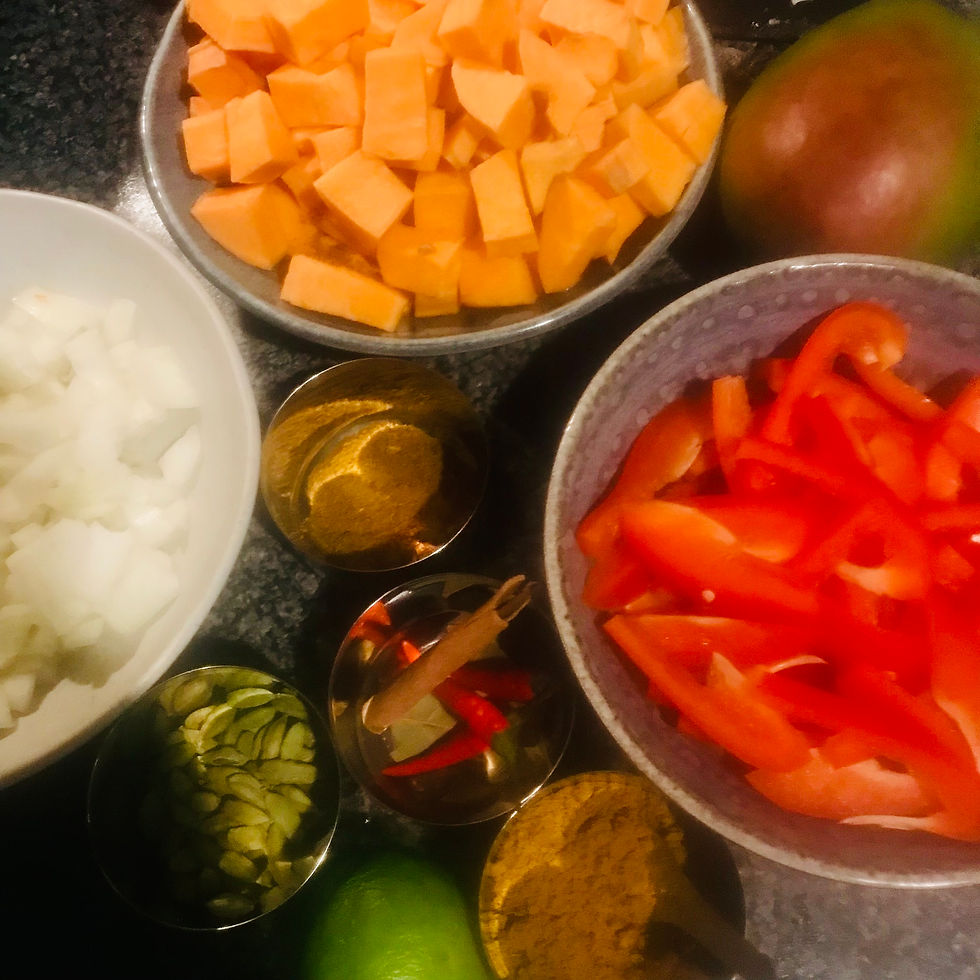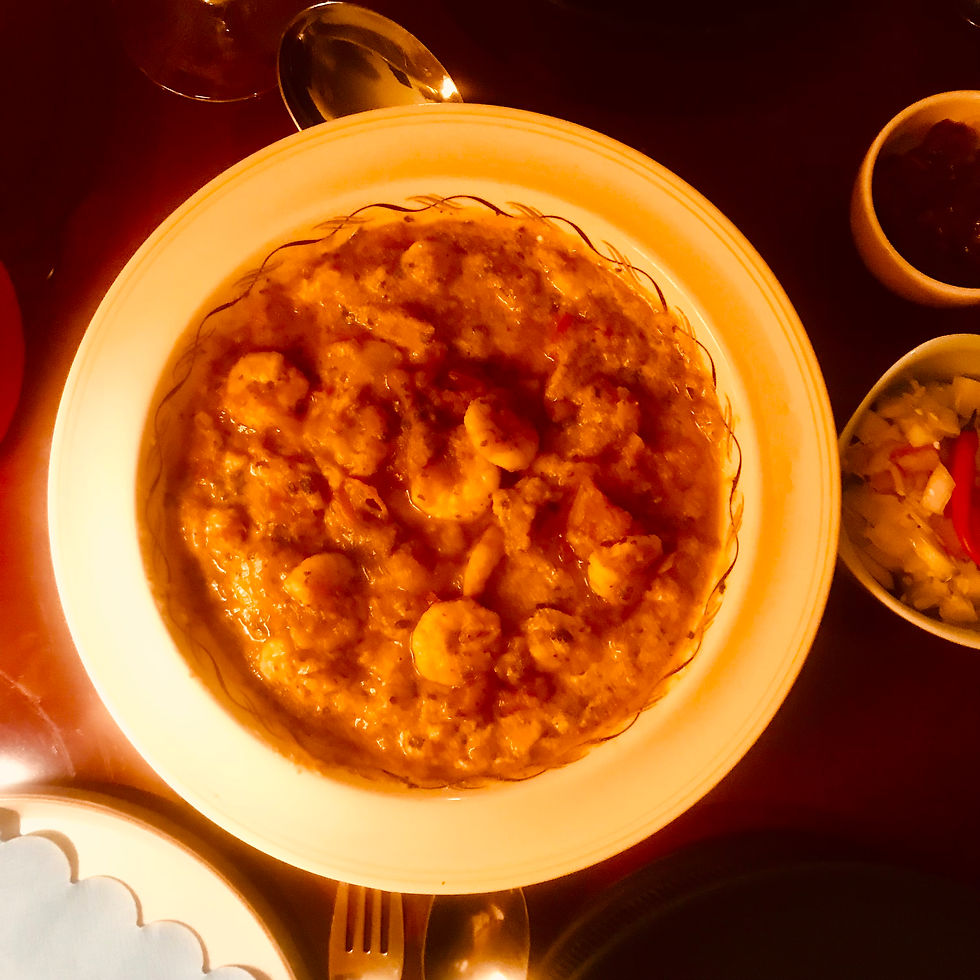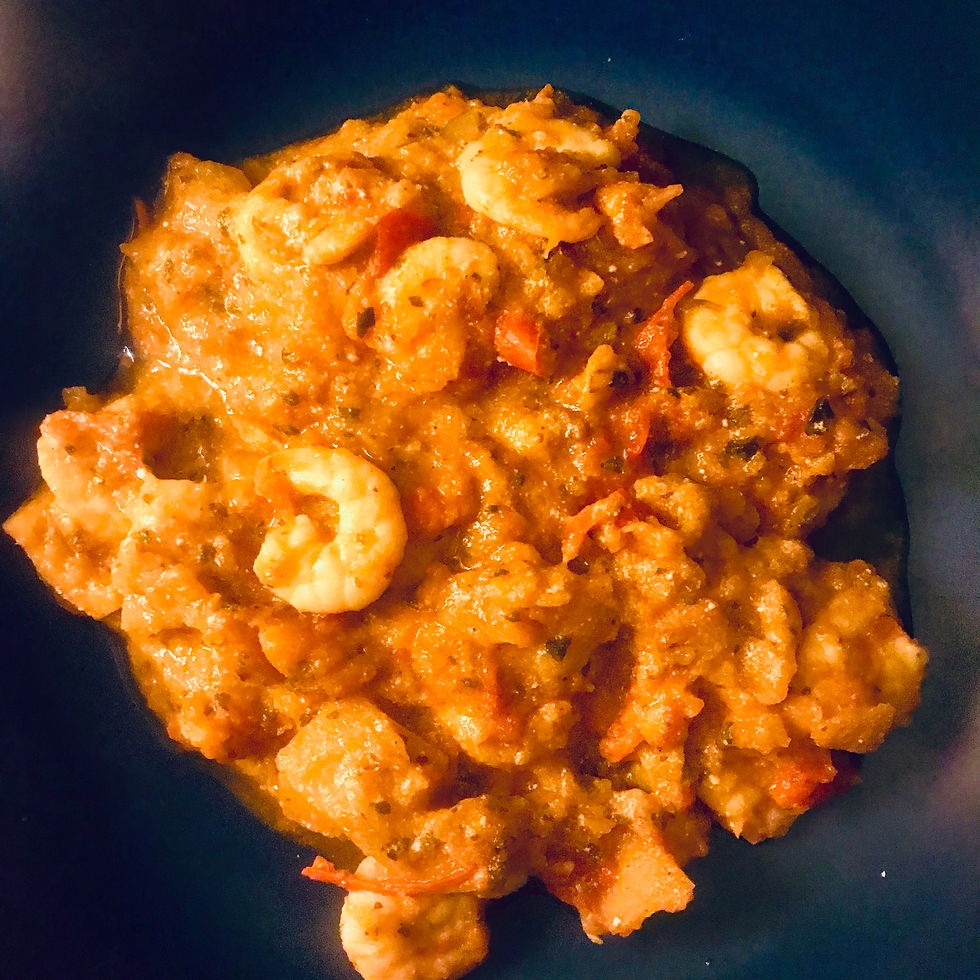This (near) zero-fat prawn and mango curry is surprisingly simple, despite the seemingly complex list of ingredients. But, though simple to cook, it isn't a very quick dish and arrives at its unique flavours with a little time and patience.

Currying favour
After bleating to a friend last week that the thing I hated most about my post-operative "no fat" adjustment diet is that it pretty much rules out my beloved Indian cuisine, kids, I have aced it. An no surprise it came from looking to the bounty of Indian Diasporan cooking from South Africa yet again.
Just to make it even more complicated, not only was I trying to cook a curry with flavour and body with roughly only 3g of fat per serving, but I was also cooking for my partner Luc, who likes spices, but is not good with heat. That might seem a bit of a contradiction in terms: looking to the culinary traditions of KwaZulu-Natal—famed for its fiery "Durban curries"—to arrive at a mild curry full of flavour. Yet, it really works.
It's based on two simple principles. The first is that I didn't mix my own curry spices as per usual. While I have all the spices and ordinarily would, I don't trust myself enough to arrive at quantities that deliver a mild curry. So, being hugely pragmatic, I opted for Sainsbury's Mild Curry Powder. That way, if it proved too hot for him, I would blame a large national supermarket chain. If you want me to tell you how to create it yourself, hit me up: I'm not going to get into blending 14 spices unnecessarily here...
The second principle is based on some knowledge of chemistry combined with the instinct of someone experienced in cooking Indian food. In simplistic terms the combination of sweet potato and mango is a winner. The former has a tendency to add body to curries. It doesn't entirely break up, but as it cooks, it lends a certain substance to the sauce. The latter—mango is an ingredient often used in Indian Diasaporan cooking in KwaZulu-Natal—brings the additional benefit of aiding reduction through its fruity sugar content eschewing the use of "stodgy" ingredients such as cornflour.
As mentioned elsewhere on this site, rice is more commonly favoured with KwaZulu-Natalian dishes. However, here I went with my gut instinct and opted for naan breads.
Shopping list

the curry spices
2 tbspns mild curry powder
2 tbspns garam masala
1 cinnamon stick, snapped in half
8 green cardamom pods, broken
4 dried bay leaves
for the zero-fat prawn and mango curry
½ tbspn peanut oil (or sunflower oil)
2 tspns garlic & ginger paste
1 400g tin of chopped tomatoes in their juice (preferably not plum tomatoes)
1 hot red chilli, chopped
2 tbspns of light soy sauce
2 medium white or brown onions, cubed
Approx. 300g shelled raw king prawns, fresh or defrosted
1 large fresh mango; cut away from the stone and roughly cubed
2 red bell peppers, cut into vertical slices
2 sweet potatoes, peeled and cut into large cubes
1 vegetable stock cube/jelly, diluted in approx. 300ml boiling water
2 fresh limes
6 heaped tbspns of fresh coriander; de-stalked and finely chopped
Approx. 75g 0% fat Greek-style yoghurt
salt and freshly ground black pepper

for the sambals and condiments
1 small onion, finely cubed
6 cherry tomatoes; finely cubed
A little vinegar
2 tbspns desiccated coconut
Approx. 100ml natural yoghurt
Approx. 15cm of a cucumber, finely cubed or grated
A small clutch of fresh coriander, finely chopped
Cooking Method
for the zero-fat prawn and mango curry
Since this is a near-zero fat version, there are things you need to do before starting the main dish. You can do these some time before. First, place the cubed onions and chopped red chilli in a microwave-proof dish. Add the juice and pulp of 1 lime and 2 tbspns of light soy. Cover and microwave on full power (900W) for 4mins, stirring halfway through
Place the sliced red bell pepper on a non-stick tray and dry-roast in a pre-heated oven at 250°C for 15 to 20mins—better still for about 12mins in a halogen oven—and then allow to rest once par-cooked
Heat a non-stick pan on a high heat. Add ½ a tspn of garlic & ginger paste while the pan is still heating. As soon as the paste begins to sizzle, add the defrosted prawns and sprinkle over 1 tbspn of garam masala. Stir in the dry pan until the spice begins to catch. Then add the juice of ½ a fresh lime. Together with the juices the prawns exude, this will prevent sticking. Cook until the king prawns are about 75% cooked. This will only take a few minutes. Remove from the heat and put to one side
Add ½ tbspn peanut oil to a large pot with a lid and heat on a high heat. Add the remaining garlic & ginger paste to the pan. When it begins to sizzle, stir and allow to brown for a minute of so. Add the pre-cooked onions and chilli to the pot, along with any juices. Add 2 tbspns of mild curry powder and 1 tbspn of garam masala and the remainder of the lime juice. Stir and sauté. It is likely to "cook dry" and start sticking fairly quickly. Add a little stock—a few tbspns at a time—to prevent sticking.
Add the par-roasted red bell peppers and stir in. Even with only a little stock, the ingredients will generate enough liquid. Reduce the heat, cover and sweat until all of the ingredients are cooked
Add the tomatoes. Pour the remainder of the stock into the tomato can, swish around, and pour into the pot. Add the sweet potato pieces and the cinnamon stick. Stir, cover and increase the heat once again. Boil vigorously for 5mins
Reduce to a low heat—you want the liquid to gently bubble—and simmer gently for at least 40mins, stirring occasionally
By now the curry will have reduced somewhat. Taste it: this is the point at which you decide whether you want to add additional spices and chilli
Add the remaining coriander and cubed mango—and the whole mango stone—to the top of the pot. Re-cover without stirring. Simmer for 20mins before stirring. Stir and reduce to a heat where the contents are barely simmering. Simmer on this very low heat until the mango is cooked. This usually takes about 15 to 20mins. More importantly, the curry should have notably reduced
Continue to cook on this low heat for a further 10mins; until it's optimally cooked. Add the prawns and all of their juices and gently fold in. Cook for a further few minutes, until the prawns are perfectly cooked. Lift out the mango stone and remove the pot from the heat. Rest for a few minutes then gently stir in the yoghurt. Decant to a serving dish and cover before taking to table
When you've prepared all the condiments and heated the naan breads in the oven, take the curry to table so diners can serve themselves.
Side Dishes
Basmati rice—particularly "Durban yellow rice" (cooked with turmeric)—would be the natural accompaniment with this dish. However, I went with whimsy and served it with oven-warmed garlic naan breads. Do as you will.
Condiments
South African Indian Diasporan food is usually served with raw sambals and condiments. In this case I've opted for these:
sambal — chopped tomatoes, onions, cucumber and desiccated coconut in vinegar and lime juice
raitha— 0% fat yoghurt, grated cucumber and finely chopped coriander
chutney—a 19th-century Mrs Beeton classic; orchard fruits to run contrapunto to the tropical fruits in the dish itself

Alternatives
Vegans and vegetarians: the simplest thing is to simply ignore the king prawns and to incrementally increase the quantities of red bell pepper, mango and sweet potato. This is actually a delicious dish before the prawns arrive and it doesn't need anything else. And, though I probably shouldn't say it, the late arrival of the yoghurt is a bit unnecessary.
Pescatarians, duh, this is a pescatarian dish. Carnivores? Prior to doing the ultra-low fat version, I often cooked a more traditional version of this dish with chicken. Essentially, you cook bite-sized pieces of skinless chicken in the same way as you do the king prawns above. Given that they should only be three-quarter cooked before you add them to the curry, you need to cook them in the sauce longer than you do the king prawns; roughly 5 to 6mins.
Pairings
Another of those dishes that's somewhat "colour agnostic" I tend to have it with whites as often as with reds.
On this occasion we had it with a solid-'n-simple Spanish Rioja Blanco that was to hand. It worked well with the mango and prawns and I certainly wouldn't discourage anyone exploring the white Rioja path. But, had I had more time to think about it, I suspect I would have taken the route of looking for a more ballsy white. I retain my vehement assertion the South African chenin blancs are overall the best white wines to take curries on on their own terms and I stand behind that here. For example, try it with something like Boekenhoutskloof Porcupine Ridge Chenin Blanc 2021 if you can.
That said, this is exactly the kind of curry that works wonderfully with beer. I'm certain it would work wonderfully with the no-frills, crisp flavour of the SAFA classic Castle Lager. Or try it with the Belgian Vedett Extra Pilsner, the ace Staropramen Czech lagers (including the excellent booze-free versions) or even the hipster Camden Hells Lager.
Going booze free? My top tip with this one is iced Teapigs Rooibos Tea on the rocks with a slice of fresh lime.











Comments